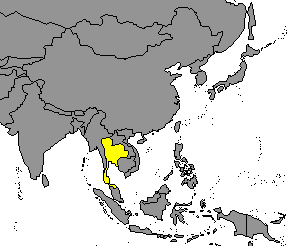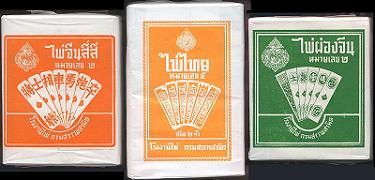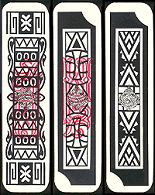DISCLAIMER
the content of these galleries is a private property
neither the text nor the pictures may be republished, nor used for any purpose, without the author's permission
I thank the Aiempatanasuk family and Luca & Nui
for their valuable contribution to this section.
NOTE
due to romanization (i.e. the spelling of Oriental words in Western letters, based
on their original sound)
some names might have more than one spelling.
THAILAND
 |
Also in Thailand, the most westernized among the southeastern Asian countries,
the descendants of the many Chinese immigrants keep alive the use of traditional
homeland patterns, but in the past few decades the number of players has considerably
decreased.

|

THAI CARDS
The pattern locally called Pai Tai
(simply "Thai cards") basically matches the Ceki decks of Indonesia and Malaysia.
The composition is the same one as the latter: three suits (Coins, Strings and
Myriads) of nine cards each, and three individual special subjects ( Old Thousand,
Red Flower and White Flower), each of which is repeated twice for a total of 60 cards,
plus a spare blank one.
Red stamps appear on the usual subjects ( Old Thousand, Red Flower and
9 of Strings).
In this case the shape of the cards is long and thin, as most Chinese editions, and
their plain backs are deep orange in colour, as the ones of the DongGuan cards (described in
the Chinese gallery, page 1), or green. |

the three special subjects:
Old Thousand, Red Flower
and White Flower |
However, quite a few typical differences of the Thai variety can be told.

from the left: 1 and 9 of Coins, Strings and Myriads |
A first general feature is that all the subjects of the deck are double-ended: each
of them may be looked at from both sides, on which not only the index frame but also the
inner part of the illustration is perfectly symmetrical to its opposite half. The
wrapper of the deck mentions this feature as "two head type".
The patterns of the black index frames are the same ones described for Indonesian or
Malaysian Ceki cards, and follow the same ordering, but the one for "9" has a reversed
position (compare the last card of the picture on the left with the index table in
page 1). |
Furthermore, the central illustrations do not feature
personages from "The Water Margin" novel, as in China, Indonesia and Malaysia, but
only geometrical shapes: the stylized faces do not appear in the Thai edition.

FOUR COLOUR CARDS
The Pai Jîn Sì Sí, or "Chinese four
colour cards", is a pattern made of 112 cards, divided into four suits of
different colour (yellow, red, green and white, in decreasing value).

|
The seven subjects in each suit are taken from Chinese chess: General, Mandarin,
Minister, Chariot, Horse, Cannon and Soldier, repeated four times.
This pattern is identical to the one found in China, the "long" variety of Si Se Pai,
yet the Thai cards can be told by one detail: they have yellow backs, whereas all the
Chinese editions have them in black (a standard feature, see the Chinese gallery
page 3).
|

a General from each colour, standing next to
a Soldier,
a Cannon, a Chariot and a
Mandarin |

"CHARIOT·HORSE·CANNON" (CHINESE CHESS) CARDS

Soldier, Cannon, Horse, Chariot, Mandarin and (red) General |
Pai Pong Jîn, literally
"Chinese gorgeous, bright cards", is the peculiar name given in
Thailand to the two colour Chinese chess pattern.
It has the same basic composition mentioned in the Chinese gallery
part 2: each of the two sides (black suit and white
suit) has General, Mandarin, Minister, Chariot, Horse and Cannon repeated eight times,
while there are ten cards of the lowest rank, the Soldier, and no "special" subjects. |
|
 |
The total number of cards in a pack is 116, and unlike the four colour pattern their corners
are sharp.
There are no special subjects, but the highest rank, i.e. the General, features a
particularly ornate illustration, and in one of the two suits it is red.
The backs are plain, either orange or green. |

the same subjects from the opposing side |
PLAYING CARD REGULATIONS IN THAILAND

above and to the right: samples of Thai tax bands |
Thailand is one of the few countries whose government still holds the
monopoly for the sale of playing cards. Each new deck has to bear the tax seal
of the government's bureau, in the shape of a label glued to the wrapper or box.
 |
|
|
The laws concerning the sale and the use of playing cards are somewhat strict:
no gambling is allowed in public, whence the absence of casinos in Thailand, although
in private houses this is a frequent practice. In shops, decks may be purchased only by
adults (over 18).
Playing cards in Thailand are only printed by one state manufacturer, whose seal
appears in the center of all the subjects of traditional patterns and on the ace of Spades of
Poker decks.
A limited number of editions are legally imported from abroad. Poker
decks manufactured outside the country must carry a curious mini-stamp on every card, including the
joker (see picture on the right). |

the mini-stamp on
each imported card |
|
 |
go to
OTHER GALLERIES






















or back to

INTRODUCTION
AND HISTORY
|

MULTI-LANGUAGE
GLOSSARY |

THE FOOL &
THE JOKER |

INDEX
TABLE |

REGIONAL
GAMES |

PLAYING CARD
LINKS |